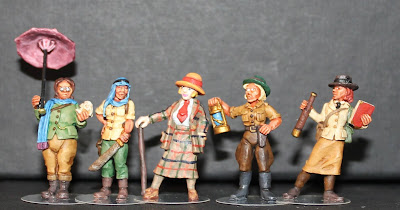Sergeant Archibald Cutter, Sergeant 'Mac' MacChesney and Sergeant Thomas 'Tommy' Ballantine
Gunga Din
by Rudyard Kipling
You may talk o’ gin and beer
When you’re quartered safe out ’ere,
An’ you’re sent to penny-fights an’ Aldershot it;
But when it comes to slaughter
You will do your work on water,
An’ you’ll lick the bloomin’ boots of ’im that’s got it.
Now in Injia’s sunny clime,
Where I used to spend my time
A-servin’ of ’Er Majesty the Queen,
Of all them blackfaced crew
The finest man I knew
Was our regimental bhisti, Gunga Din,
He was ‘Din! Din! Din!
‘You limpin’ lump o’ brick-dust, Gunga Din!
‘Hi! Slippy hitherao
‘Water, get it! Panee lao,
‘You squidgy-nosed old idol, Gunga Din.’
The uniform ’e wore
Was nothin’ much before,
An’ rather less than ’arf o’ that be’ind,
For a piece o’ twisty rag
An’ a goatskin water-bag
Was all the field-equipment ’e could find.
When the sweatin’ troop-train lay
In a sidin’ through the day,
Where the ’eat would make your bloomin’ eyebrows crawl,
We shouted ‘Harry By!’
Till our throats were bricky-dry,
Then we wopped ’im ’cause ’e couldn’t serve us all.
It was ‘Din! Din! Din!
‘You ’eathen, where the mischief ’ave you been?
‘You put some juldee in it
‘Or I’ll marrow you this minute
‘If you don’t fill up my helmet, Gunga Din!’
’E would dot an’ carry one
Till the longest day was done;
An’ ’e didn’t seem to know the use o’ fear.
If we charged or broke or cut,
You could bet your bloomin’ nut,
’E’d be waitin’ fifty paces right flank rear.
With ’is mussick on ’is back,
’E would skip with our attack,
An’ watch us till the bugles made 'Retire,’
An’ for all ’is dirty ’ide
’E was white, clear white, inside
When ’e went to tend the wounded under fire!
It was ‘Din! Din! Din!’
With the bullets kickin’ dust-spots on the green.
When the cartridges ran out,
You could hear the front-ranks shout,
‘Hi! ammunition-mules an' Gunga Din!’
I shan’t forgit the night
When I dropped be’ind the fight
With a bullet where my belt-plate should ’a’ been.
I was chokin’ mad with thirst,
An’ the man that spied me first
Was our good old grinnin’, gruntin’ Gunga Din.
’E lifted up my ’ead,
An’ he plugged me where I bled,
An’ ’e guv me ’arf-a-pint o’ water green.
It was crawlin’ and it stunk,
But of all the drinks I’ve drunk,
I’m gratefullest to one from Gunga Din.
It was 'Din! Din! Din!
‘’Ere’s a beggar with a bullet through ’is spleen;
‘’E's chawin’ up the ground,
‘An’ ’e’s kickin’ all around:
‘For Gawd’s sake git the water, Gunga Din!
’E carried me away
To where a dooli lay,
An’ a bullet come an’ drilled the beggar clean.
’E put me safe inside,
An’ just before ’e died,
'I ’ope you liked your drink,’ sez Gunga Din.
So I’ll meet ’im later on
At the place where ’e is gone—
Where it’s always double drill and no canteen.
’E’ll be squattin’ on the coals
Givin’ drink to poor damned souls,
An’ I’ll get a swig in hell from Gunga Din!
Yes, Din! Din! Din!
You Lazarushian-leather Gunga Din!
Though I’ve belted you and flayed you,
By the livin’ Gawd that made you,
You’re a better man than I am, Gunga Din!








































